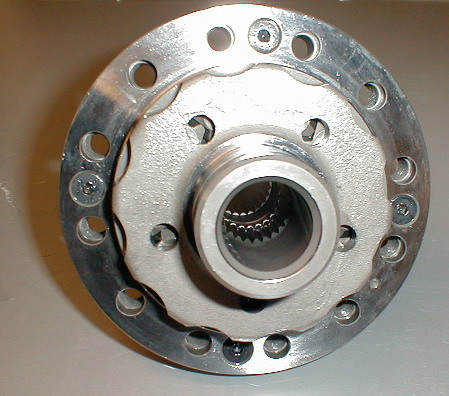
Q2

Alfa Romeo’s Q2 system embodies all the strengths of front-wheel drive, while significantly increasing roadholding, traction and stability on the over-run and attenuating understeer on acceleration, delaying the intervention of the electronic control systems, and reducing steering wheel vibration.
Two practical examples below highlight the technical potential of the Q2 system.
Taking a corner when grip is poor (wet road, snow, mud, etc.) or with a sporty driving style, grip can be lost on the inside wheel. When the transfer of the lateral load takes weight off the suspension, torque on the inside wheel is reduced, and a conventional differential (which splits the same torque value between both wheels) transfers an equal amount of torque to the outside wheel, but this is insufficient for good traction.
In this situation the car can respond in two different ways, depending on the equipment fitted. On a model without ASR-VDC, the perceived result is the slipping of the inside wheel, a loss of control of the car (strong understeer) and a loss of acceleration coming out of the bend. If, on the other hand, the car is equipped with ASR-VDC, the intervention of the driving assistance systems takes power from the engine, acting on the throttle valve and the braking system, so that it becomes impossible to modulate the accelerator, producing the unpleasant sensation of a drop in power.
In both cases, the result is that as the car comes out of the bend, the driver has the feeling that it is ‘stationary’.
And with the Q2 system in place?
When the inside wheel starts to lose grip, torque is partially transferred to the outside wheel, producing less understeer, greater stability, and increasing cornering speed.
The improved mechanical efficiency of the Q2 transmission delays the intervention of the vehicle control systems, guaranteeing better traction as the car exits the bend, which makes driving more enjoyable while maintaining complete control of the vehicle.
Surfaces with poor grip
On surfaces with poor grip, it is quite common for the driven wheels to have different degrees of grip. For example, grip under the two wheels can differ on snow-covered or wet roads.
In these conditions, starting off or accelerating sharply can cause the wheels to slip, generating critical friction conditions, a strong reaction on the steering wheel, and inadequate take-off, making it necessary to correct the steering wheel continuously to maintain the trajectory.
And with the Q2 system present?
These negative effects are attenuated by the gradual transfer of torque to the wheel that can exploit the best friction coefficient, simplifying a hill start, for example, and making driving on all roads with changing surface conditions safer and more comfortable.
*preuzeto sa sajta
http://www.carpages.co.uk/alfa_romeo/al ... -10-07.asp
E-Q2
Making its debut on the Alfa 159 2008 model (Saloon and Sportwagon), Brera 2008 and Spider 2008 models is the Electronic Q2. Combining all the advantages of front-wheel drive, enhanced driving pleasure and control, and guaranteeing some of the advantages typical of an all wheel drive system. As a result, the system is matched perfectly to the torque capacity and power output, raising yet further the already excellent performance of these models.
The system works as follows. The Electronic Q2 system makes use of the brake system components, which in turn are controlled in an efficient manner by the ESP control module. The resulting effect is very similar to a limited slip differential (such as a mechanical Torsen differential). In particular, when accelerating out of a curve, the front wheel brake calipers apply torque to the internal wheel, so increasing the grip of the wheel. The traction is permanently balanced in a dynamic manner between the front and rear wheels, according to driving-and road-surface conditions. The Electronic Q2 is linked exclusively to the front wishbone suspension, allowing for a particularly efficient and sporty tuning of the vehicle.
Alfa Romeo, in fact, gained an excellent reputation among it's clients for its front suspension (it's not by chance that many in the motor industries apply our solution). Needles to say, that beyond the overall advantages of this type of design (weight, on-board comfort etc.), when in tight-driving conditions, the understeer prone character of front wheel drive allows the driver to respond to the vehicle’s needs more intuitively. It's here, that the sensation of front-wheel drive is being more “genuine” than a rear-wheel driven vehicle.
Instead, in the all wheel drive versions the Electronic Q2 is mated to the rear axle, further increasing the already famous easy and pleasant driving characteristics of the Q4, and in doing so, conferring a greater perception of sportiness. The performance is that of an integrated all wheel drive system with central Torsen differential and rear self-locking electronic differential.
To emphasize all these qualities, Alfa Romeo has put in place the Electronic Q2 system which has all the advantages of front-and-all wheel drive. Noticeably increasing: road holding, handling, stability, while at the same time reducing understeer and the need for corrective steering-wheel movements
Thanks to the evolution of electronics and hydraulic stability control systems, Alfa Romeo is able to modulate, in a continuous manner, the torque transfer to the wheels based on grip, vehicle speed and lateral acceleration. This means that nowadays, with the new E-Q2 function it is possible to control the braking, in a proportionate manner, of the particular wheel, which is about to lose grip and allow for the optimal torque transfer in terms of the best compromise between traction (in terms of acceleration) and the intended course.
The extent of the E-Q2 system’s intervention depends on: throttle position, selected gear, engine rpm, and difference in slip between the internal and external wheels.
This system represents an evolutionary leap for front wheel driven vehicles compared with conventional traction control systems, as illustrated below. When accelerating out of curve, without E-Q2, the internal wheel is subjected to a load reduction, thus increasing wheel slip and, because of the presence of a conventional differential, resulting in reduced traction capacity for the entire axle. Simultaneously, because of the traction loss, the vehicle tends to widen its course (understeer). The E-Q2 system, on the other hand, applies brake force to the inner wheel by means of a signal from the VDC control module, resulting in a torque increase to both drive shafts and therefore also transferring torque o to the external wheel with grip.
The E-Q2 system allows the driver to reach higher lateral acceleration levels during cornering, reducing understeer and the necessary steering angle to maintain the intended course.
Therefore we can say that the active intervention of the E-Q2 system is improving cornering traction while controlling understeer at the same time. The perceived effect is similar to that of a Q2 front differential; the moment in which internal wheel slip occurs, for example when accelerating in a curve, the E-Q2 slightly applies brake force to the internal wheel to allow torque to be transferred to the external wheel, thus maintaining speed and intended course.
The effect is perceptible until the limit of the external wheel’s grip is reached, at which point the conventional traction control (ASR) intervenes by limiting engine torque and/or through application of the brakes.
This means that the ASR intervenes at the moment when both wheels start loosing grip, which is more pronounced because of the torque cut and activation of the brake system.
The E-Q2 system works independently of the VDC system regardless of being part of the same vehicle stability control system: VDC intervenes in case of excessive over-or-understeer when it detects excessive rotation of the vehicle with respect to its vertical center axis, also when no power is being transferred to the driven wheels or with excessive steering being applied.
Mangoletsi.
*preuzeto sa sajta
http://www.mangoletsi.com/alfa/news/alf ... ation.html
bice prevedeno uskoro
nadogradnja Alfe sa Q2 differencijalom
http://www.alfaworkshop.co.uk/156-147-G ... tial.shtml


